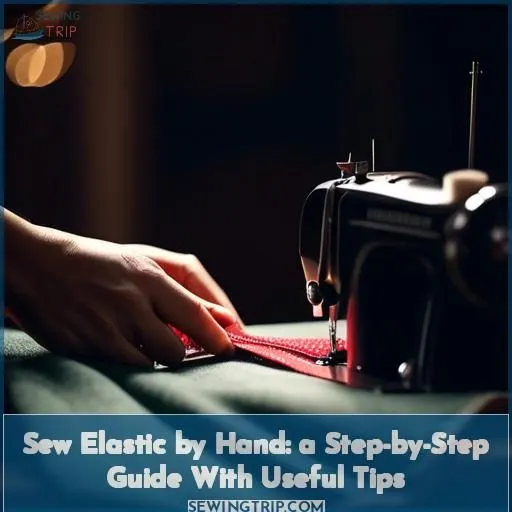This site is supported by our readers. We may earn a commission, at no cost to you, if you purchase through links.
To sew elastic by hand, first measure and cut the elastic to size, overlapping the ends by 0.25-0.5 inches and stitching them together. Divide the elastic and waistband into quarters to ensure even distribution. Pin the elastic to the waistband, matching the marks, then use a zigzag stitch to attach it.
Alternatively, create an elastic casing by inserting the elastic into an enclosure, guiding it through with a safety pin, aligning the ends, and stitching the casing closed. For a secure attachment, use a backstitch.
Table Of Contents
Key Takeaways
- Measure and cut the elastic to size, overlapping the ends by 0.25-0.5 inches and stitching them together.
- Divide the elastic and waistband into quarters to ensure even distribution.
- Use a zigzag stitch to attach the elastic to the waistband or create an elastic casing by inserting the elastic into an enclosure and stitching the casing closed.
- Sew the elastic to an edge by hand by measuring and cutting the elastic to size, overlapping the ends, and using a zigzag stitch to attach it to the edge.
How to Sew Elastic by Hand?
To sew elastic by hand, follow these steps:
- Fold your elastic into a loop and overlap the ends by ½ inch (12mm). Stitch the ends together using a zigzag stitch across the edges 2 or 3 times to prevent bulging.
- Measure the waistband or cuff of your garment and cut the elastic to the appropriate length. If you want the elastic to fit snugly, subtract some length from the measurement.
- Pin the elastic to the wrong side of the waistband or cuff, matching the quarter marks. Make sure the edge of the elastic is about 0.25 inches (0.64 cm) from the edge of the fabric.
- Sew the elastic to the garment using a zigzag stitch, making sure to pull the fabric and elastic flat as you sew to guarantee proper stretch.
Remember to use ballpoint or stretch sewing needles, a Teflon sewing foot, and a good quality polyester thread when sewing elastic to an edge.
Sewing Elastic to an Edge
To sew elastic to an edge by hand, start by measuring and cutting the elastic to size. Overlap the ends by 0.25 to 0.5 inches and stitch them together using a good quality polyester thread.
Divide the elastic into quarters and mark the edge of the waistband or cuff into quarters. Pin the elastic onto the wrong side of the waistband or cuff, matching the quarter marks. Use a zigzag stitch to attach the elastic to the edge.
Test the elasticity before sewing to make sure it has a high recovery rate. Use a running stitch or stretch stitch for loose elastic, and a backstitch for a more secure attachment.
Creating a Casing for Elastic
Creating an enclosure for elastic is an essential step in stitching elastic to an edge. Here’s a step-by-step guide on how to create an enclosure for your elastic:
- Measure the Enclosure Width: Measure the width of the elastic and add 0.5 inches.
- Fold Over the Fabric: Fold over this amount of fabric into the garment and pin it in place.
- Mark the Enclosure Opening: Mark the area where you want to leave the opening using a piece of chalk or pins.
- Sew the Enclosure Stitch: Sew a straight stitch about 0.25 inches from the edges of the fabric.
- Insert the Elastic: Insert the elastic into the enclosure using a large safety pin.
- Guide the Pin Through the Enclosure: Guide the pin through the enclosure, avoiding losing the elastic.
- Pull the Elastic Out: Pull the elastic out enough to match the ends.
- Align and Stitch the Elastic: Align the elastic and stitch it into place.
- Switch the Opening to Finish: Switch the opening to finish the enclosure.
Remember to use a basting stitch or herringbone stitch for a stretchy fabric like knit elastic. Use a hand stretch stitch for knitted elastic for a more professional finish.
Frequently Asked Questions (FAQs)
What is the difference between braided, knit, and woven elastic?
As the old saying goes, Variety is the spice of life. Braided elastic is sturdy, knit elastic is stretchy, and woven elastic is smooth. Each type has its own unique properties that can suit different sewing needs.
How do I measure the elastic for a specific project?
Measure the area you need to cover with elastic, then subtract 1-2 inches for a snug fit. Mark the elastic at quarter points to align evenly with your garment. This guarantees a comfortable, customized result.
What is the best method to sew elastic directly onto a garment?
90% of seamstresses report less fabric shifting when sewing elastic directly onto a garment. Stretch the elastic as you zigzag-stitch it to the fabric, then fold it over and secure with another zigzag stitch. Easy to master this technique!
How do I create a casing for elastic?
To create a casing for elastic, simply measure the width of the elastic, add 5 inches, then fold this amount of fabric into the garment. Pin it in place, mark the opening, and stitch along the edges.
How do I sew elastic into a casing?
Slip that slippery eel – the elastic – into its stylish, snug casing with the dexterity of a seasoned tailor. Wrangle that wayward band, guiding it through the opening while keeping it taut and aligned. Now, stitch it securely in place.
Conclusion
Well, there you have it! By now, you should feel like a pro at sewing elastic by hand.
Whether you opt for the direct approach of attaching the elastic directly to the waistband or create a cozy casing, the key is to measure, mark, and stitch with precision.
With these time-tested techniques in your toolkit, you’ll be able to tackle any project that calls for the versatile and comfortable addition of sew elastic by hand.
Go forth and sew with confidence!









